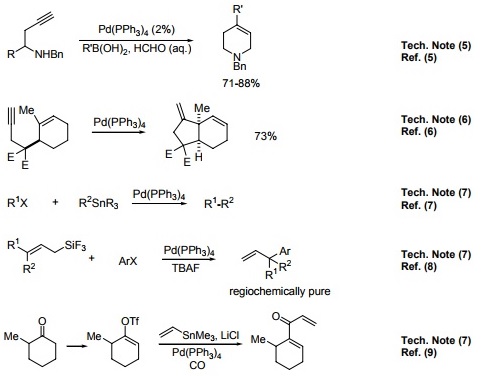Tetrakis(triphenylphosphin)palladium Chemische Eigenschaften,Einsatz,Produktion Methoden
Beschreibung
Tetrakis(triphenylphosphin)-palladium(0) ist m??ig l?slich in Benzol (50 g/L), Dichlormethan und Chloroform. Die Verbindung ist weniger l?slich in Aceton, Tetrahydrofuran und Acetonitril. In ges?ttigten Kohlenwasserstoffen ist sie unl?slich. Obwohl der Komplex an der Luft gehandhabt werden kann, wird er am besten unter Stickstoff aufbewahrt, um seine Reinheit zu gew?hrleisten.
Eigenschaften
Tetrakis(triphenylphosphin)-palladium(0) ist m??ig l?slich in Benzol (50 g/L), Dichlormethan und Chloroform. Die Verbindung ist weniger l?slich in Aceton, Tetrahydrofuran und Acetonitril. In ges?ttigten Kohlenwasserstoffen ist sie unl?slich. Obwohl der K
Synthese
2 PdCl2 + 8 PPh3 + 5 NH2NH2 · H2O → 2 Pd(PPh3)4 + 4 NH2NH2 · HCl + N2 + 5 H2O
In einem 2-L-Rundkolben mit Magnetrührst?bchen werden Palladium(II)-dichlorid (17.72 g, 0.10 mol) und Triphenylphosphin (131 g, 0.50 mol) in 1200 ml DMSO unter Stickstoffatmosph?re zusammengegeben. Die gelbe Mischung wird unter Rühren so lange auf einem ?lbad erhitzt, bis sich alles l?st (ca. 140 °C). Das ?lbad wird entfernt und die L?sung 15 min kr?ftig gerührt. Innerhalb von einer Minute wird Hydrazin-Hydrat (20 g, 0.40 mol) mittels einer Spritze durch das Septum hinzugegeben. Eine heftige Reaktion unter Bildung von Stickstoff findet statt (Druckausgleich mittels Ballon). Die schwarze L?sung wird sofort mit einem Wasserbad gekühlt. Die Kristallisation beginnt ab ca. 125 °C. Ab diesem Punkt l?sst man das Reaktionsgemisch ohne Wasserbad weiter abkühlen. Nachdem die Mischung Raumtemperatur erreicht hat, wird sie unter Stickstoff durch eine Glasfilternutsche filtriert. Der Feststoff wird nacheinander mit je zweimal 50 ml Ethanol und Diethylether gewaschen. Das Produkt wird durch Einleiten eines schwachen Stickstoffstroms durch die Glasfilternutsche über Nacht getrocknet. Das resultierende gelbe, kristalline Produkt wiegt 103.5 bis 108.5 g (90-94% Ausbeute).
Quelle
Coulson, D. R. Inorg. Synth. 1990, 28, 107-109
R-S?tze Betriebsanweisung:
R20/22:Gesundheitssch?dlich beim Einatmen und Verschlucken.
R40:Verdacht auf krebserzeugende Wirkung.
R36/37/38:Reizt die Augen, die Atmungsorgane und die Haut.
S-S?tze Betriebsanweisung:
S22:Staub nicht einatmen.
S24/25:Berührung mit den Augen und der Haut vermeiden.
S36/37:Bei der Arbeit geeignete Schutzhandschuhe und Schutzkleidung tragen.
S37/39:Bei der Arbeit geeignete Schutzhandschuhe und Schutzbrille/Gesichtsschutz tragen.
S26:Bei Berührung mit den Augen sofort gründlich mit Wasser abspülen und Arzt konsultieren.
Chemische Eigenschaften
yellow crystals
Verwenden
Tetrakis(triphenylphosphine)palladium(0) is widely used as a catalyst for palladium-catalyzed coupling reactions.
Application
Palladium-Catalyzed Three-Component Reaction for the Synthesis of Imidazolidinones.

Once the Schlenk tube containing K2CO3 (55 mg, 0.40 mmol) is flamed, dried, and filled with argon, Tetrakis(triphenylphosphine)palladium (12 mg, 0.010 mmol), PMB-protected 2,3-allenylamine (37 mg, 0.20 mmol), iodobenzene (58 mg, 0.28 mmol), phenyl isocyanate (36 mg, 0.30 mmol), and CH3CN (4 mL) are added sequentially. The resulting solution is heated to and stirred at 70°C. When the reaction is completed as monitored by TLC, the solvent is evaporated under reduced pressure, and the residue is purified by chromatography on silica gel (petroleum ether : ethyl acetate = 7:1) to afford the corresponding imidazolidione (72 mg, Y. 96%) as an oil.
Reaktionen
- Catalyst for Suzuki coupling of chiral secondary organoboronic esters.
- Palladium-catalyzed SNAr reactions for the synthesis of heteroaryl ethers.
- Catalyst for cross-coupling of a-diazocarbonyl compouns with arylboronic acids.
- Diastereoselective synthesis of trans-1,2-diazetidines.
- Palladium-catalyzed alkynyl iminium ion cyclization.
- Widely used reagent in a variety of transformations including Heck arylation, enyne and diyne cycloisomerization.
- Catalysts for cross-coupling.


l?uterung methode
The palladium complex is recrystallised from EtOH. It should not be heated excessively as it dissociates to Pd(PPh3)3 and PdPh3 and then further to Pd(PPh3)2 and PPh3. It is also air sensitive as PPh3 is oxidized to PPh3O. It is stable only for short periods because on exposure to heat or air it turns from yellow to orange and dissociates in solution so the solutions should be used directly. However it can always be prepared freshly by mixing Pd(NO3)2 (2mmols) and PPh3(2mmols) in hot *C6H6 when vigorous evolution of nitric oxide occurs and a solid mass separates. This is collected and crystallised from EtOH. Its cryoscopic constant in *C6H6 (at 0.601g/20mL) corresponds to M 1156 [Malatesta & Angoletti J Chem Soc 1186 1957]. It is a useful catalyst for Suzuki coupling reactions [Trost Tetrahedron 33 2615 1977]. [Beilstein 16 IV 954.] This palladium catalyst bound to a polymer support (~0.06mmol/g) is also commercially available [cf Fenger & LeDrain Tetrahedron Lett 39 4287 1998]. [Beilstein 16 IV 954.]
Tetrakis(triphenylphosphin)palladium Upstream-Materialien And Downstream Produkte
Upstream-Materialien
Downstream Produkte

